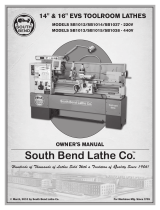
OPERATING LEVERS
Metal Lathe Operating Levers (Fig.2)
Headstock Levers
•Levers 1 & 2 located on the fornt side of the headstock allow you to
s
et the desired speed from 60-1500 RPM.
•Lever 11 starts and stops the spindle. If lever 11 is placed in the up
p
osition, the spindle will turn counterclockwise. If lever 11 is placed
in the down position, the spindle will turn clockwise.
Quick Change Gear Box Levers
•Lever 4 is a threading or turning selection lever. There are 3
positions, left position for turning operation, center position for
neutral setting and the right position for threading operation.
•Levers 5 & 6 control the gear box feed rate. Lever 5 has 5 positions
and lever 6 has 8 positions. Moving these two tumbler levers can
provide many feed rates and inch thread pitches as indicated in the
charts in the metal lathe plates. With the use of metric change gears,
the two tumbler levers can also provide metric threads using the “MM
Gear Change” chart which is also found in the metal lathe plates.
Caution: Always stop the spindle before engaging any of the
above levers (Levers 4-6).
Carriage Assembly Levers
• Handwheel 7 is used to manually move the carriage along the
bedway of the lathe.
• The crossfeed handwheel 19 is used to manually move the cross
slide in or out.
• The top slide handwheel 16 is used to manually move the tool post.
The top slide is fully adjustable to any angle and is also used for
threading or machining an angle on a workpiece.
• The thread lever 9 is used to engage the half nuts when threading.
• The feed lever 8 is used to engage either the longitudinal or cross
feed. This lever has a safety interlock to prevent accidental
engagement of the half nuts when the lathe is in feed mode. There
are 3 positions; the upper position engages the power longitudinal
feed, the lower position engages the power cross feed and the
center position is the disengaged position.
•
The lead/feed lever 3 is used to change the direction of either the
longitudinal or cross feed, yet without changing the direction of the
s
pindle rotation.
• The thread cutting dial 10 is used to engage the half nuts with the
leadscrew in the same thread that has been previously cut. Please
note: Use any line of the dial for even pitches of threads, but for odd
pitches of threads you must use the same starting line. Example:
When cutting a shaft with 10 T.P.I., engage the half nuts at any
number on the thread dial, when creating an odd pitch, if you start
the cut using 1 or a 3, continue to use the 1 or the 3 until the thread
is finished.
• The clamp lever 18 is used to secure the tool post block.
• Saddle lock screw 17 is used to firmly clamp the saddle to the bedway.
• Top slide set screw 20 is used to clamp the top slide to the cross
slide.
Tailstock levers
• The handwheel 12 is used to feed or retreat the tailstock quill. Tip:
Turning the handwheel completely couterclockwise until a full stop
will automatically eject the turning tool used.
• The tailstock clamp lever 13 locks the tailstock to the bedway. To
lock, pull the lever upwards, to release lower the lever.
• The tailstock quill lock lever 15 prevents the quill from moving.
• The 2 set screws 14 on either side of the base are used to offset the
tailstock. After taper adjustments are made, retighten both set
screws.
12
18
16 17
15
13
14
10
9
20
7
19
8
11
1
2
3
4
5
6
FIGURE 2













